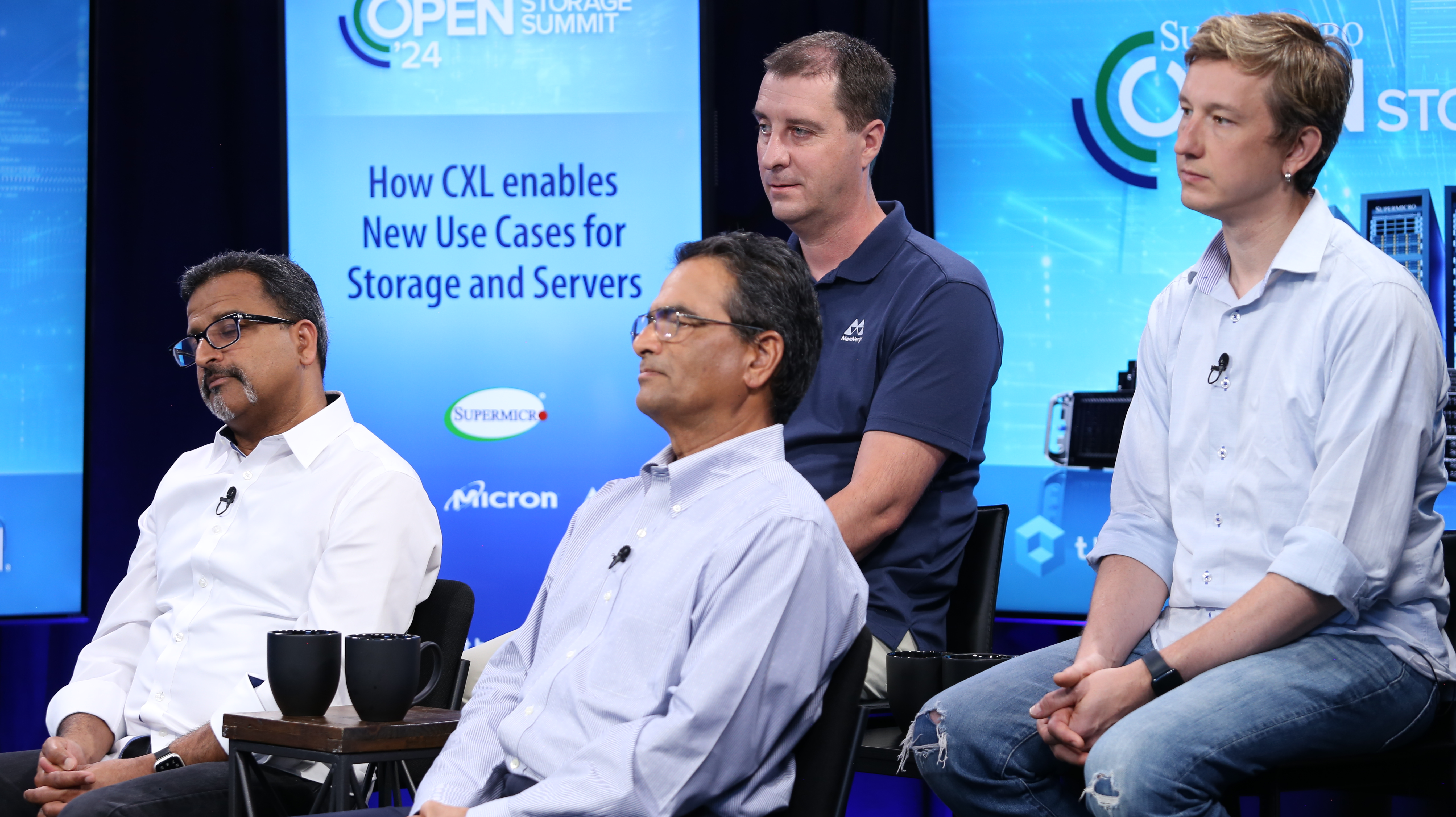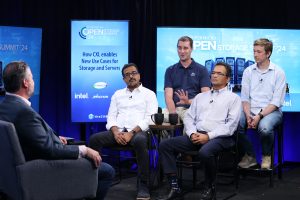 BIG DATA
BIG DATA
 BIG DATA
BIG DATA
 BIG DATA
BIG DATA
As the demand for real-time data processing escalates, the technology behind Compute Express Link, known as CXL, is emerging as a critical solution for modern data centers. CXL memory is one solution that addresses the challenges presented by the rapid growth of applications such as generative AI, autonomous driving and in-memory databases.
It achieves this by offering high speed and low latency, which significantly boosts data throughput and scalability. This transformative approach enables the development of more efficient and powerful data center infrastructures, according to Andrey Kudryavtsev (pictured, back row, right), senior manager of CXL business development at Micron Technology Inc.

Supermicro’s Puneet Anand, Intel’s Anil Godbole, Micron’s Andrey Kudryavtsev and MemVerge’s Steve Scargall talk about CXL memory.
“What I’m saying is not only applicable to AI, it’s applicable to all generic compute,” Kudryavtsev said. “It has so many different applications, and memory application is just one of these. And being [from] a memory company, of course I want to give you a memory perspective of why CXL makes so much sense these days.”
Kudryavtsev was joined by Puneet Anand (front row, left), senior product manager of storage systems at Super Micro Computer Inc.; Anil Godbole (front row, right), Xeon CXL strategy and marketing manager at Intel Corp.; and Steve Scargall (back row, left), director of product management for CXL and AI at MemVerge Inc., as they spoke with theCUBE Research’s Rob Strechay during the Supermicro Open Storage Summit event series, during an exclusive broadcast on theCUBE, SiliconANGLE Media’s livestreaming studio. They discussed the crucial role of CXL memory in modernizing data centers by providing high-speed, low-latency memory solutions essential for advanced applications, such as AI, autonomous driving and big data analytics. (* Disclosure below.)
CXL memory, introduced by the CXL Consortium in 2019, is poised to revolutionize data center architectures by providing a unified interface standard that significantly enhances data throughput, reduces latency and improves scalability. Unlike traditional methods, CXL leverages existing PCIe interfaces, enabling lower latency and faster data processing by maintaining memory coherency across CPUs and accelerators, according to Godbole.
“CXL is from the get-go is meant as a cache and memory coherent link between the processor and the device. It runs on the same rails or the PHYs as the PCI links,” Godbole said. “That means we didn’t have to invent new IO ties … you simply run CXL as an alternate protocol or the existing PCI links of the processor, but CXL will allow or will lend itself to having lower latency and therefore higher performance compared to PCI.”
One of the standout benefits of CXL is its ability to repurpose older memory technologies, such as DDR4, allowing organizations to upgrade infrastructure without investing in entirely new hardware. This capability is especially advantageous for cloud service providers, which can provision minimal memory on servers and access additional capacity from a CXL-attached memory pool as needed. This flexibility not only reduces costs, but also ensures that data centers can scale efficiently to meet the demands of evolving workloads, according to Scargall.
“We work closely with all our partners here, and of course the operating system is the first level of software that needs to run on top of the platforms,” he said. “The great news there is that in the past one or two years, Linux has been working very closely on CXL enablement. If your operating system is available, has been used in the past one or two years, then it’ll have CXL support. If not, then our own MemVerge memory machine has the capability of transparently tiering memory on behalf of unmodified applications.”
Supermicro, known for its speed of execution and foresight in technology adoption, has positioned itself as a leader in integrating CXL into its product offerings. The company is committed to staying ahead of the curve, citing its early adoption of the Enterprise and Datacenter Standard Form Factor format as an example of its proactive approach, according to Anand.
“One thing that I’ve also seen here is the foresightedness that the leaders have had,” he said. “Way back when in 2017, EDSFF format was just coming up. We were already there ready with a product. Our first EDSFF Petascale product actually came out in 2017, and when the [Open Compute Project] guys came up with DC-MHS and other standards, we were right there.”
Supermicro’s latest platform, based on Petascale Xeon processors, is a testament to its dedication to innovation, Anand added. This platform, which supports up to eight CXL memory modules, provides organizations with the ability to significantly expand memory capacity while maintaining a balanced architecture that optimizes airflow and performance.
“This new platform is based on our new Petascale Xeon 6,” Anand said. “What we did is we used this platform to introduce the Micron CXL memory … we are very excited to have this product out there.”
The consensus among industry leaders is clear: The future of memory and data center architecture is here, and it’s being driven by CXL. The industry is at a pivotal moment, reminiscent of the early days of NVMe SSDs, according to Scargall. The rapid adoption of CXL is set to disrupt the memory market in a similar fashion, enabling organizations to break through the memory wall and achieve unprecedented levels of performance.
“I mean the future is now. Our software is ready to go for the devices that are available today,” Scargall said. “We’ve got emulation of future devices. We’re able to use that technology to further our software development so that again, we’re ready for when that hardware lands, and I’m super excited for what pooling and definitely what sharing can do for us in the very near future here.”
Here’s the complete video interview, part of SiliconANGLE’s and theCUBE Research’s coverage of the Supermicro Open Storage Summit event series:
(* Disclosure: TheCUBE is a paid media partner for the Supermicro Open Storage Summit event series. Neither Super Micro Computer Inc., the sponsor of theCUBE’s event coverage, nor other sponsors have editorial control over content on theCUBE or SiliconANGLE.)
Support our mission to keep content open and free by engaging with theCUBE community. Join theCUBE’s Alumni Trust Network, where technology leaders connect, share intelligence and create opportunities.
Founded by tech visionaries John Furrier and Dave Vellante, SiliconANGLE Media has built a dynamic ecosystem of industry-leading digital media brands that reach 15+ million elite tech professionals. Our new proprietary theCUBE AI Video Cloud is breaking ground in audience interaction, leveraging theCUBEai.com neural network to help technology companies make data-driven decisions and stay at the forefront of industry conversations.